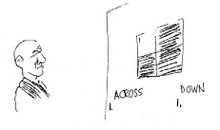Friday, September 1, 2017
From This Valley
they say you are going...
The basic proposition behind the science of climate change is so firmly rooted in the laws of physics that no reasonable person can dispute it. All other things being equal, adding carbon dioxide (CO2) to the atmosphere—by, for example, burning millions of tons of oil, coal and natural gas—will make it warm up.
That, as the Nobel Prize–winning chemist Svante Arrhenius first explained in 1896, is because CO2 is relatively transparent to visible light from the sun, which heats the planet during the day. But it is relatively opaque to infrared, which the earth tries to reradiate back into space at night.
Oceans absorb vast amounts of heat, slowing the warm-up of the atmosphere, yet they also absorb excess CO2. Vegetation soaks up CO2 as well but eventually re¬releases the gas as plants rot or burn—or, in a much longer-term scenario—drift to the bottom of the ocean to form sedimentary rock such as limestone.
It is also no surprise that James Hansen, director of the NASA Goddard Institute for Space Studies, has been circulating a preprint of a journal paper saying that the outcome of global warming is likely to turn out worse than most people think.
Although the full impact of this temperature increase will not be felt until the end of this century (when humans will cease to exist), the point at which major climate disruption is inevitable is already upon us. “If humanity wishes to preserve a planet similar to that on which civilization developed and to which life on Earth is adapted,” the paper states, “CO2 will need to be reduced from its current 400 ppm [parts per million] to 350 ppm.”
The problem is that a conventional projection for how warm things will get come out of a calculation everyone knows is wrong. Called the Charney sensitivity, it estimates how much the global mean temperature will rise if atmospheric CO2 is doubled from its preindustrial levels, before people began burning coal and oil on a grand scale. But the Charney sensitivity is an oversimplification. The calculation does take into account some feedback mechanisms that can modify the effects of increasing temperatures on short time¬scales—changes in water vapor, clouds and sea ice, for example.
Using that record, Hansen concludes that even if the human race could maintain today’s level of atmospheric CO2 , sea level would rise several meters thanks to the disintegration of continental ice sheets. Moreover, he thinks disintegration may happen much faster than one might naively expect. “We didn’t have convincing data on this until we had the gravity satellites,” he says, referring to GRACE, a pair of orbiters that can detect tiny local changes in the earth’s gravitational field. “Greenland has gone from a stable ice mass in 1990 to accelerating ice loss.
Another big surprise is West Antarctica, where despite little actual warming, the ice shelves are melting.” As those partially floating ice shelves melt, land-based glaciers are free to slide more rapidly to the sea. In Greenland, meltwater from the top of the glaciers is evidently pouring down through cracks to lubricate the underside of the ice sheets, easing their flow out to the ocean.
Warming temperatures, Hansen says, not only increase the amount of meltwater on the surface of the ice but also increase rainfall. “Ice-sheet growth,” he says, “is a dry process. Disintegration is a wet process, so it goes a lot faster.”
The transition to large-scale glaciation in Antarctica began, the researchers estimate, when CO2 dropped to 425 ppm, plus or minus 75 ppm. Most of the ice should therefore disappear again if we reach that point—and if all of Antarctica’s and Greenland’s glaciers were to melt, sea level would rise many tens of meters.
Given Hansen’s eminence as a climate scientist, one might expect that his analysis would have triggered a general panic. And it has—but not among scientists. “This month may have been the most important yet in the two-decade history of the fight against global warming,” wrote journalist and author Bill McKibben in the Washington Post this past December.
Subscribe to:
Post Comments (Atom)



















No comments:
Post a Comment